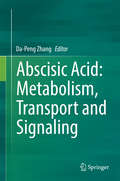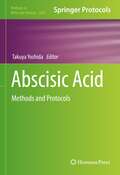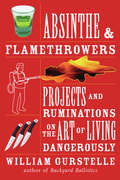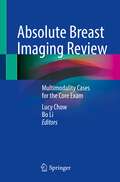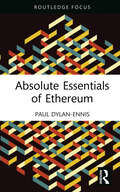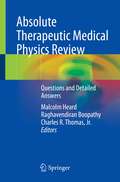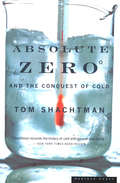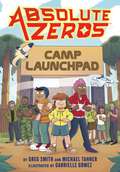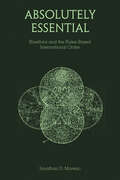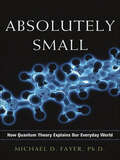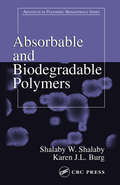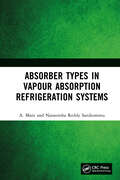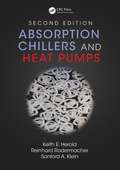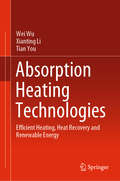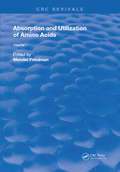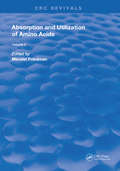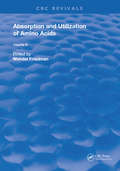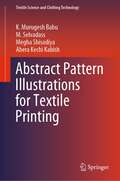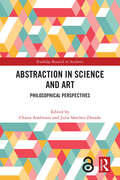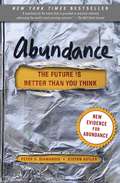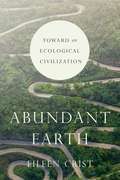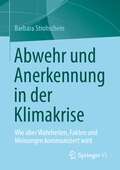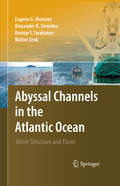- Table View
- List View
Abscisic Acid: Metabolism, Transport And Signaling
by Da-Peng ZhangThis book provides a comprehensive review of all aspects of the molecular and cell biology of abscisic acid (ABA) metabolism, transport and signal transduction, covering our current understanding of ABA as well as research trends. The agricultural significance of ABA metabolism, transport and signal transduction is also discussed. The phytohormone ABA regulates many aspects of plant development and plays a central role in plant adaptation to environmental stresses. Over the past few decades, considerable advances have been made in the study of ABA metabolism, transport and signal transduction, greatly deepening our understanding of the underlying mechanisms of ABA function at the molecular, cell and whole-plant level and helping us improve crops' environmental tolerance. This book provides a valuable resource for researchers and advanced students interested in plant biology and agriculture.
Abscisic Acid: Methods and Protocols (Methods in Molecular Biology #2462)
by Takuya YoshidaThis volume presents an all-inclusive overview of molecular biological methods to study ABA signaling transport, and metabolism in several plant species. The chapters in this book cover topics such as biochemical and molecular biological characterization of ABA receptors; assay systems for ABA transporters; quantification and visualization of ABA levels; and comprehensive omics approaches. Written in the highly successful Methods in Molecular Biology series format, chapters include introductions to their respective topics, lists of the necessary materials and reagents, step-by-step, readily reproducible laboratory protocols, and tips on troubleshooting and avoiding known pitfalls. Cutting-edge and thorough, Abscisic Acid: Methods and Protocols is a valuable resource for scientists and researchers who are interested in learning more about this developing field.
Absence of Mind: The Dispelling of Inwardness from the Modern Myth of the Self
by Marilynne RobinsonEssays from the lectures delivered at Yale University, the Dwight Harrington Terry Foundation. Includes bibliographical references.
Absence of Mind: The Dispelling of Inwardness from the Modern Myth of the Self
by Marilynne RobinsonIn this ambitious book, acclaimed writer Marilynne Robinson applies her astute intellect to some of the most vexing topics in the history of human thought--science, religion, and consciousness. Crafted with the same care and insight as her award-winning novels, Absence of Mind challenges postmodern atheists who crusade against religion under the banner of science. In Robinson's view, scientific reasoning does not denote a sense of logical infallibility, as thinkers like Richard Dawkins might suggest. Instead, in its purest form, science represents a search for answers. It engages the problem of knowledge, an aspect of the mystery of consciousness, rather than providing a simple and final model of reality. By defending the importance of individual reflection, Robinson celebrates the power and variety of human consciousness in the tradition of William James. She explores the nature of subjectivity and considers the culture in which Sigmund Freud was situated and its influence on his model of self and civilization. Through keen interpretations of language, emotion, science, and poetry, Absence of Mind restores human consciousness to its central place in the religion-science debate.
Absinthe & Flamethrowers: Projects and Ruminations on the Art of Living Dangerously
by William GurstelleWritten for reasonable risk takers and suburban dads who want to add more excitement to their lives, this daring combination of science, history, and DIY projects explains why danger is good for you and details the art of living dangerously. All of the projects--from throwing knives, drinking absinthe, and eating fugu to cracking a bull whip, learning baritsu, and building a flamethrower--have short learning curves; are human-focused, as opposed to technology-centric; are affordable; and demonstrate true but reasonable risk. The guide maintains that risk takers are more successful, more interesting individuals who lead more fulfilling lives. What would the world be like if Thomas Edison retired after 30 years working for the railroad, it asks, instead of getting fired for blowing up a rail car with one of his experiments? Though the manual doesn't advocate getting fired, it does reveal that making black powder is pure excitement. Unlike watching an action movie or playing a video game, real, edgy life experience changes a person. Each potentially life-altering project includes step-by-step directions and illustrations along with sidebar tips from experts in the field.
Absolute Breast Imaging Review: Multimodality Cases for the Core Exam
by Bo Li Lucy ChowThis book presents over 500 breast imaging questions with detailed answers to prepare readers for the Radiology Core Exam. Radiology residents looking for preparation materials to use for the Core Exam are often frustrated with the lack of resources available. This book addresses that lack by providing an informative and invaluable high-yield breast imaging case review book for board review and lifelong learning purposes. Editors and authors have collected numerous high quality breast imaging cases that directly align with each diagnosis the Core Exam has included in their study guide. Cases include modalities from mammogram, ultrasound, and MRI. High quality images are included for each case. The book is structured to follow the layout and topics of the ABR Study Guide, making all material boards-relevant. Within each section, cases are presented with boards-style multiple choice questions and detailed explanations, giving the reader over 500 breast imaging questions to learn from. Cases will include diagnosis, etiology, imaging characteristics, and management. Additional topics related to boards preparation and clinical practice are also addressed, including indications for screening, regulations, physics, and quality/safety. This is an ideal guide for radiology residents preparing for the breast imaging portion of their Radiology Core Examination, and for continued practice and learning for practicing radiologists.
Absolute Essentials of Ethereum (Absolute Essentials of Business and Economics)
by Paul Dylan-EnnisAbsolute Essentials of Ethereum is a concise textbook which guides the reader through the fascinating world of the emerging Ethereum ecosystem, from the basics of how its blockchain works to cutting-edge applications.Written by an experienced educator, each chapter is designed to progress potential students from class to class. Technical concepts are clearly explained for those new to the topic and readers are supported with definitions and summaries in each chapter. Real-life case studies situate the overviews in a contemporary context. Topics covered include the Ethereum Execution and Consensus layers, Ethereum governance and community, Decentralised Autonomous Organisations (DAOs), Decentralised Finance (DeFi), Non-Fungible Tokens (NFTs) and Layer 2.This book is the ideal text to support undergraduate and postgraduate courses on blockchain technologies, cryptocurrencies, Web3 and fintech, as well as for those who want to know how Ethereum really works.
Absolute Therapeutic Medical Physics Review: Questions and Detailed Answers
by Charles R. Thomas Malcolm Heard Raghavendiran BoopathyThis book is a comprehensive study guide for the therapeutic medical physicist pursuing initial board certification and those participating in continuing education. Medical physics is an evolving field as a result of rapidly developing technology and the focus on evidence-based care in radiation oncology. Recently, the certification body has mandated an online question and answer system to allow practicing physicist to receive continuing education credits. The questions are designed to test the walking around knowledge of the clinical physicist. Many physicists specialize in specific treatment modalities, thus limiting their exposure to other areas of clinical physics. This handbook allows these physicists to stay up-to-date and satisfy the requirements of the certification body. The text is divided into 2 main sections: Questions & Detailed Answers. Question chapters are divided by the ABR content guide and are composed of 15-35 questions. Questions are primarily multiple choice in nature with 4-5 possible answers, but there are also matching questions. Questions review the scope of medical physics, spanning from medical physics theories to day-to-day applications in clinic. The questions and detailed answers will be set in such a way to address most relevant and commonly tested topics of dosimetry, treatment machine, treatment planning, protection, radiobiology, radiation safety and professionalism and ethics. The questions will most closely fit to what is done in clinical practice. Detailed answers not only explain the correct answer, but also discuss the erroneous remaining answers with the appropriate citation of the most recent protocols, guidelines, publications and task group recommendations. This is an ideal study guide for therapeutic medical physicists in training and in practice, who need to pass a written board examination or prepare themselves for their continuing education requirements.
Absolute Zero and the Conquest of Cold
by Tom Shachtman&“A lovely, fascinating book, which brings science to life.&” —Alan Lightman Combining science, history, and adventure, Tom Shachtman &“holds the reader&’s attention with the skill of a novelist&” as he chronicles the story of humans&’ four-centuries-long quest to master the secrets of cold (Scientific American). &“A disarming portrait of an exquisite, ferocious, world-ending extreme,&” Absolute Zero and the Conquest of Cold demonstrates how temperature science produced astonishing scientific insights and applications that have revolutionized civilization (Kirkus Reviews). It also illustrates how scientific advancement, fueled by fortuitous discoveries and the efforts of determined individuals, has allowed people to adapt to—and change—the environments in which they live and work, shaping man&’s very understanding of, and relationship, with the world. This &“truly wonderful book&” was adapted into an acclaimed documentary underwritten by the National Science Foundation and the Alfred P. Sloan Foundation, directed by British Emmy Award winner David Dugan, and aired on the BBC and PBS&’s Nova in 2008 (Library Journal). &“An absorbing account to chill out with.&” —Booklist
Absolute Zeros: Camp Launchpad (Absolute Zeros #1)
by Michael Tanner Greg Smith Einhorn's Epic ProductionsReach for the stars in this exciting graphic novel about three ambitious, space-loving kids who must put their differences aside to save their summer camp before it closes...for good. Welcome to Camp Launchpad! Summer is in full swing, which means a new class of kids has arrived to attend the best space camp in Florida...or at least, it used to be. With growing competition from the trendy rival camp next door, Camp Launchpad needs all the help it can get to keep its doors open. Campers Val, Mark, and Pete are here for very different reasons: following in the footsteps of an astronaut mom, living up to expectations as a vice president&’s son, or getting a once-in-a-lifetime scholarship. But they all have one huge thing in common: Their future in the stars launches from here...if there&’s still a camp to launch from. When the hotshot owner of the rival space camp makes a ten-million-dollar bet that could turn Camp Launchpad around, this unlikely trio must band together to pull off a miracle. If they don&’t, this could be Camp Launchpad&’s last summer ever!
Absolutely Essential: Bioethics and the Rules-Based International Order (Basic Bioethics)
by Jonathan D. MorenoWhat the end of the post-World War II global political system means for bioethics and beyond.In Absolutely Essential, Jonathan Moreno explores the field of bioethics as both a creature and a key element of the post–World War II rules-based order. According to this order, international relations are to be organized according to principles of open markets, liberal democracy, and multilateral organizations.Drawing on the author&’s four decades of experience in the field, the book raises key questions about the future of bioethics in a changed world order, while also theorizing new ways to think about bioethics after the COVID-19 pandemic and the reordering of global alliances. For bioethicists, this book will contextualize the field in an entirely new light, while readers unfamiliar with bioethics will appreciate that this seemingly esoteric field is in fact a paradigmatic creation of the global system now undergoing sweeping change.
Absolutely Small: How Quantum Theory Explains Our Everyday World
by Michael D. FayerAbsolutely Small presents (and demystifies) the world of quantum science like no book before.Physics is a complex, daunting topic, but it is also deeply satisfying?even thrilling. When liberated from its mathematical underpinnings, physics suddenly becomes accessible to anyone with the curiosity and imagination to explore its beauty. Science without math? It&’s not that unusual.For example, we can understand the concept of gravity without solving a single equation. So for all those who may have pondered what makes blueberries blue and strawberries red; for those who have wondered if sound really travels in waves; and why light behaves so differently from any other phenomenon in the universe, it&’s all a matter of quantum physics.This book explores in considerable depth scientific concepts using examples from everyday life, such as:particles of light,probability,states of matter,what makes greenhouse gases badChallenging without being intimidating, accessible but not condescending, Absolutely Small develops your intuition for the very nature of things at their most basic and intriguing levels.
Absorbable and Biodegradable Polymers (Advances In Polymeric Biomaterials Ser.)
by Shalaby W. Shalaby Karen J.L. BurgInterest in biodegradable and absorbable polymers is growing rapidly in large part because of their biomedical implant and drug delivery applications. This text illustrates creative approaches to custom designing unique, fiber-forming materials for equally unique applications. It includes an example of the development and application of a new absor
Absorber Types in Vapour Absorption Refrigeration Systems
by A. Mani Narasimha Reddy SanikommuThis book addresses the increasing energy demand and costs associated with the global refrigeration industry, primarily driven by the need for cooling. It proposes the substitution of vapour compression refrigeration systems (VCRS) with vapour absorption refrigeration systems (VARS), which operate on low-grade, renewable energy sources like solar, geothermal, and waste heat.Focusing on the absorber component of VARS, which plays a critical role in facilitating heat and mass transfer processes, the book provides a comprehensive overview of absorber configurations, including tray, packed bed, falling film, spray, bubble, and membrane absorbers. It offers guidance on selecting the appropriate absorber configuration considering their advantages and limitations in different operating conditions, as well as their numerical, experimental, and performance enhancement studies.The book will interest heating, ventilation, and air conditioning (HVAC) academic researchers, graduate students, and professionals involved in the advancement of sustainable refrigeration technologies, particularly absorber selection.
Absorption Chillers and Heat Pumps
by Keith E. Herold Reinhard Radermacher Sanford A. KleinSignificantly revised and updated since its first publication in 1996, Absorption Chillers and Heat Pumps, Second Edition discusses the fundamental physics and major applications of absorption chillers. While the popularity of absorption chillers began to dwindle in the United States in the late 1990's, a shift towards sustainability, green buildin
Absorption Heating Technologies: Efficient Heating, Heat Recovery and Renewable Energy
by Wei Wu Xianting Li Tian YouThis book offers a comprehensive introduction to novel absorption heating technologies for improving the energy efficiency of heating systems. The proposed low-temperature heating systems, based on an air source absorption heat pump (ASAHP), significantly increase heating efficiency and reduce pollution emissions. As the performance of ASAHPs deteriorates at lower ambient/driving temperatures, a series of advanced cycles is used to extend their applicability, with the compression-assisted ASAHP being the most outstanding example. The book discusses the generator-absorber-heat-exchange ASAHP as a promising solution to make the best of high driving temperatures, an aspect that can be improved further via compression. Further, it addresses the ground source absorption heat pump (GSAHP), which eliminates the soil thermal imbalance of the conventional ground source electrical heat pump (GSEHP), and also reduces the number of boreholes . Various hybrid GSAHP systems are proposed to further enhance applicability, efficiency, and economy: these include a combined GSAHP and GSEHP system, as well as ASAHP and GSAHP systems that incorporate design optimizations. In closing, the book explores the merits of novel working fluids and highlights recent advances concerning waste heat and renewable energy utilization.
Absorption and Utilization of Amino Acids: Volume I
by Mendel FriedmanContaining 45 papers written by outstanding international authors from 14 countries, this three-volume compendium brings together the elements needed to understand the factors which influence the utilization of amino acids. The wide-ranging topics include descriptions of metabolic pathways and mechanisms of the biological utilization of amino acids, as well as factors that influence amino acid bioavailability in enteral and parenteral nutrition. The use of amino acids to improve the quality and safety of the diet is presented. Also discussed are amino acid precursors of biogenic amines and the role of amino acids in atherosclerosis, cancer, and immunity. Scientists from many disciplines will benefit from this broad overview.
Absorption and Utilization of Amino Acids: Volume II
by Mendel FriedmanContaining 45 papers written by outstanding international authors from 14 countries, this three-volume compendium brings together the elements needed to understand the factors which influence the utilization of amino acids. The wide-ranging topics include descriptions of metabolic pathways and mechanisms of the biological utilization of amino acids, as well as factors that influence amino acid bioavailability in enteral and parenteral nutrition. The use of amino acids to improve the quality and safety of the diet is presented. Also discussed are amino acid precursors of biogenic amines and the role of amino acids in atherosclerosis, cancer, and immunity. Scientists from many disciplines will benefit from this broad overview.
Absorption and Utilization of Amino Acids: Volume III
by Mendel FriedmanContaining 45 papers written by outstanding international authors from 14 countries, this three-volume compendium brings together the elements needed to understand the factors which influence the utilization of amino acids. The wide-ranging topics include descriptions of metabolic pathways and mechanisms of the biological utilization of amino acids, as well as factors that influence amino acid bioavailability in enteral and parenteral nutrition. The use of amino acids to improve the quality and safety of the diet is presented. Also discussed are amino acid precursors of biogenic amines and the role of amino acids in atherosclerosis, cancer, and immunity. Scientists from many disciplines will benefit from this broad overview.
Abstract Pattern Illustrations for Textile Printing (Textile Science and Clothing Technology)
by K. Murugesh Babu M. Selvadass Megha Shisodiya Abera Kechi KabishThis book is intended for textile designers, fashion designers, and for those interested in the integration of graphic design with textile surface printing. The book discusses how abstract graphic designs with intense color palette range work on different types of fabrics, will be beneficial for designers. The book provides beautiful illustrations of abstract designs that can be used directly for textile printing and also acts as inspiration (or motivation) for development of new designs. Abstract designs represent an accurate depiction of a visual reality and uses shapes, colors and forms to achieve its effect. This book provides illustrations that show the importance of color and color combinations with bright, warm and dull colors. The book presents flawless illustrations with great harmony between the diverse shapes and overall color combinations. All the illustrations in this book are explained briefly. The illustrations can also be used in other areas like wall paper design, packaging design, ceramic design and many more.
Abstraction in Science and Art: Philosophical Perspectives (Routledge Research in Aesthetics)
by Chiara Ambrosio Julia Sánchez-DoradoThis volume explores the roles and uses of abstraction in scientific and artistic practice. Conceived as an interdisciplinary dialogue between experts across histories and philosophies of art and science, this collection of essays draws on the shared premise that abstraction is a rich and generative process, not reducible to the mere omission of details in a representation.When scientists attempt to make sense of complex natural phenomena, they often produce highly abstract models of them. In the history and philosophy of art, there is a long tradition of debate on the function of abstraction, and – more recently – its relation with theories of depiction. Adopting a process-oriented perspective, the chapters in this volume explore the epistemic potential of a diversity of practices of abstracting. The systematic analysis of a wide range of historical cases, from early twentieth-century abstractionist painting to contemporary abstract photography, and from nineteenth-century physics to recent research in biology and neurosciences, invites the reader to reflect on the material lives of abstraction through concrete artefacts, experimental practices, and theoretical and aesthetic achievements.Abstraction in Science and Art: Philosophical Perspectives will be of interest to scholars and advanced students working in aesthetics, philosophy of science, and epistemology, as well as to historians of science and art, and to practicing artists and scientists interested in exploring foundational questions at the heart of the creative practice of abstracting.The Open Access version of this book, available at www.taylorfrancis.com, has been made available under a Creative Commons Attribution-Non Commercial-No Derivatives (CC-BY-NC-ND) 4.0 license.Open access for this book was funded by University College London.
Abundance: The Future Is Better Than You Think (Exponential Technology Series)
by Steven Kotler Peter H. DiamandisThe New York Times bestselling &“manifesto for the future that is grounded in practical solutions addressing the world&’s most pressing concerns: overpopulation, food, water, energy, education, health care and freedom&” (The Wall Street Journal).Since the dawn of humanity, a privileged few have lived in stark contrast to the hardscrabble majority. Conventional wisdom says this gap cannot be closed. But it is closing—and fast. In Abundance, space entrepreneur turned innovation pioneer Peter H. Diamandis and award-winning science writer Steven Kotler document how progress in artificial intelligence, robotics, digital manufacturing synthetic biology, and other exponentially growing technologies will enable us to make greater gains in the next two decades than we have in the previous 200 years. We will soon have the ability to meet and exceed the basic needs of every person on the planet. Abundance for all is within our grasp. Breaking down human needs by category—water, food, energy, healthcare, education, freedom—Diamandis and Kotler introduce us to innovators and industry captains making tremendous strides in each area. &“Not only is Abundance a riveting page-turner…but it&’s a book that gives us a future worth fighting for&” (The Christian Science Monitor).
Abundant Earth: Toward an Ecological Civilization
by Eileen CristIn Abundant Earth, Eileen Crist not only documents the rising tide of biodiversity loss, but also lays out the drivers of this wholesale destruction and how we can push past them. Looking beyond the familiar litany of causes—a large and growing human population, rising livestock numbers, expanding economies and international trade, and spreading infrastructures and incursions upon wildlands—she asks the key question: if we know human expansionism is to blame for this ecological crisis, why are we not taking the needed steps to halt our expansionism? Crist argues that to do so would require a two-pronged approach. Scaling down calls upon us to lower the global human population while working within a human-rights framework, to deindustrialize food production, and to localize economies and contract global trade. Pulling back calls upon us to free, restore, reconnect, and rewild vast terrestrial and marine ecosystems. However, the pervasive worldview of human supremacy—the conviction that humans are superior to all other life-forms and entitled to use these life-forms and their habitats—normalizes and promotes humanity’s ongoing expansion, undermining our ability to enact these linked strategies and preempt the mounting suffering and dislocation of both humans and nonhumans.Abundant Earth urges us to confront the reality that humanity will not advance by entrenching its domination over the biosphere. On the contrary, we will stagnate in the identity of nature-colonizer and decline into conflict as we vie for natural resources. Instead, we must chart another course, choosing to live in fellowship within the vibrant ecologies of our wild and domestic cohorts, and enfolding human inhabitation within the rich expanse of a biodiverse, living planet.
Abwehr und Anerkennung in der Klimakrise: Wie über Wahrheiten, Fakten und Meinungen kommuniziert wird
by Barbara StrohscheinAuf Wahrheiten, Fakten und Meinungen zur Klimafrage wird häufig öffentlich wie privat mit psychischer oder sozialer Abwehr reagiert. Gestützt auf ausgewählte psychologische und philosophische Theorien sowie Datenmaterial wird in diesem Buch gezeigt, wie Abwehr zustande kommt, wie sie wirkt und wie andererseits die notwendige Anerkennung auf verschiedenen Ebenen gelingen kann. Erst durch Anerkennung werden konstruktive Diskurse möglich. Dieses Buch bietet alle Grundlagen, um Kommunikationskonflikte zwischen Abwehr und Anerkennung in der Klimakrise theoretisch und praktisch lösen zu können.
Abyssal Channels in the Atlantic Ocean: Water Structure and Flows
by Alexander N. Demidov Eugene G. Morozov Roman Y. Tarakanov Walter ZenkThis book is dedicated to the study of structure and transport of deep and bottom waters through underwater channels of the Atlantic Ocean. The study is based on recent observations, analysis of historical data, and literature review. A strong flow of Antarctic Bottom Water from the Argentine Basin to the Brazil Basin through the Vema Channel (32 -27 S) is studied on the basis of CTD sections combined with LADCP profiling carried out annually and long-term moored measurements. The flow in the Vema Channel is mixed in the vertical direction but horizontally stratified. The mean speed of the flow is 30 cm/s and water transport is approximately 3.5 Sv. Owing to the bottom Ekman friction the dense core of the flow is usually displaced to the eastern wall of the channel. A temperature increase was found in the deep Vema Channel, which has been observed for 30 years already. The further flow of bottom water in the Brazil Basin splits in the northern part of the basin. Part of water flows to the East Atlantic basins through the Romanche and Chain fracture zones. The other part is a northwestern flow to the North American Basin. Part of the northwesterly flow propagates through the Vema Fracture Zone (11 N) into the Northeastern Atlantic basins. Flows in the Romanche, Chain, and Vema fracture zones were studied recently by CTD and LADCP profiling. An underwater cataract was found in the Chain Fracture Zone. Recent measurements in the Kane Gap show that the flow of bottom water there is characterized by alternative transport in time. The Northeastern Atlantic basins are filled with the bottom water flowing through the Vema Fracture Zone. The flows of bottom waters through the Romanche and Chain fracture zones do not spread to the Northeast Atlantic due to strong mixing in the equatorial zone and enhanced transformation of bottom water properties. Extra material: The CTD data sets collected in abyssal channels of the Atlantic Ocean can be downloaded from http://extras.springer.com. The access to the data is organized either by means of a clickable map or tables. Investigators can download individual casts organized by the year of the experiment or its location. The CTD data are organized in the form of a heading and three columns (pressure, temperature, salinity). The style is similar to the WOCE format. A line with coordinates is added to the heading.
